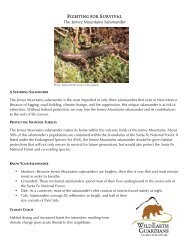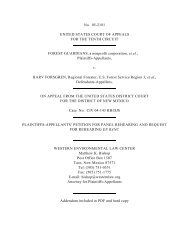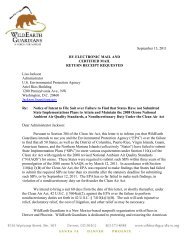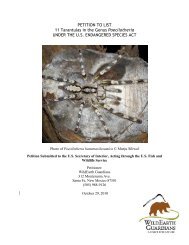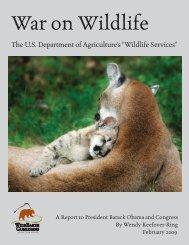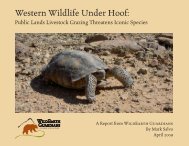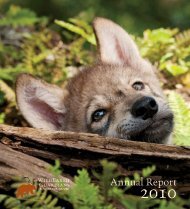PETITION TO LIST THE JEMEZ MOUNTAINS SALAMANDER ...
PETITION TO LIST THE JEMEZ MOUNTAINS SALAMANDER ...
PETITION TO LIST THE JEMEZ MOUNTAINS SALAMANDER ...
Create successful ePaper yourself
Turn your PDF publications into a flip-book with our unique Google optimized e-Paper software.
WildEarth Guardians Petition to List<br />
Jemez Mountains Salamander Under the ESA<br />
1<br />
Executive Summary<br />
WildEarth Guardians hereby petitions the U.S. Fish and Wildlife Service (FWS) to list<br />
the Jemez Mountains salamander (Plethodon neomexicanus) under the Endangered<br />
Species Act (ESA). The Petitioned species is one of only three salamanders that exist in<br />
New Mexico. 1 The Jemez Mountains salamander is the most imperiled of the three and<br />
has long been recognized as at risk within its narrow range in the north-central area of the<br />
state. In the 1980s the greatest threat to populations of Jemez Mountains salamanders and<br />
their habitat was identified as logging. Logging on the Santa Fe National Forest (SFNF),<br />
where this species primarily resides, has long been known to threaten this species. The<br />
primary threats the species currently faces are climate change, stand-replacing fires, and<br />
salvage logging.<br />
Climate change is likely an increasing threat to the Jemez Mountains salamander, given<br />
the importance of moist soils to this animal, which may suffer from habitat drying in<br />
times of drought. In addition, warmer springs and summers, earlier snowmelt, and<br />
increased drought can result in increased forest fire severity, frequency, and duration, to<br />
the detriment of the Petitioned species.<br />
The risk of stand-replacing fires on National Forest lands has increased over the last<br />
century due to fire-suppression policies. This has resulted in unnatural and excessive fuel<br />
loads which have increased the risk of fire in the Jemez Mountains salamander’s habitat.<br />
Since 1996, three large, intense, stand-replacing fires have occurred within Jemez<br />
Mountains salamander habitat. Approximately 100 square miles burned within Jemez<br />
Mountains salamander habitat. The total known range of the Jemez Mountains<br />
salamander is only 400-470 square miles, making the area affected by fire approximately<br />
equal to one-quarter of the salamander’s habitat. Of the 100 square miles affect by the<br />
three fires, 30 square miles burned with high intensity. While the Jemez Mountains<br />
salamander has existed in a habitat in which fires are a natural phenomenon, high<br />
intensity fires are not natural in this area. High-intensity fire directly kills individual<br />
salamanders and causes long-term degradation and destruction of the salamander’s<br />
microhabitat, as well as kills its prey.<br />
An indirect consequence of forest fires and their perceived threat are salvage logging,<br />
slash removal, and forest thinning treatment projects. While not all of these activities<br />
constitute a direct threat to the Jemez Mountains salamander, many proposals for these<br />
projects have not considered the viability of the Jemez Mountains salamander or its<br />
habitat as a high priority. After two of the major stand replacing fires, salvage logging<br />
sales were proposed. The preferred actions listed in the biological evaluations directly<br />
impacted habitat categorized as “Essential.” Some mitigation measures were considered<br />
but the priority of these sales placed monetary return over individual salamander survival<br />
or habitat conservation.<br />
1 The other two salamanders in New Mexico are the tiger salamander (Ambystoma tigrinum) and the<br />
Sacramento Mountain salamander (Aneides hardii) (Degenhardt et al. 1996).



